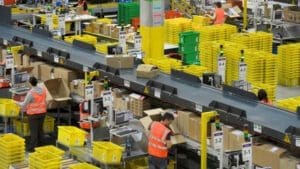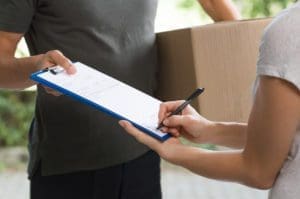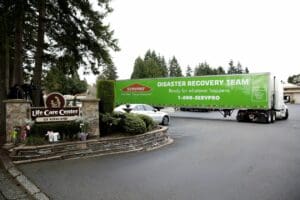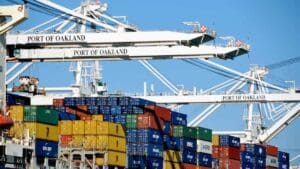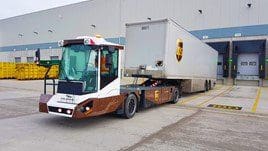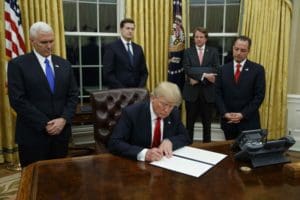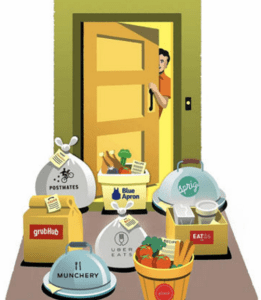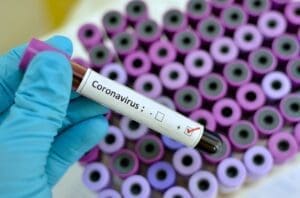 On Monday, my home state of Massachusetts announced the official details regarding the state’s four-phase plan to re-open the economy during the coronavirus pandemic. Phase 1 comes in a two-wave approach, with some business opening immediately and others opening on May 25. One group that found the approach disappointing is retailers. Many Massachusetts retailers see this plan as potentially too little too late. According to the new guidelines, nonessential retail stores will be allowed to open for curbside pickup, as well as remote fulfillment, on May 25. However, opening stores to the general public for browsing will be part of phase 2, which does not have a firm date as of now. With this announcement, e-commerce will continue to be vital for retailers looking to remain open. This will put added strain on Amazon, FedEx, and UPS to keep up with customer demands. But, the last two months, combined with the coming months will help each of these companies to succeed in the post COVID world.
On Monday, my home state of Massachusetts announced the official details regarding the state’s four-phase plan to re-open the economy during the coronavirus pandemic. Phase 1 comes in a two-wave approach, with some business opening immediately and others opening on May 25. One group that found the approach disappointing is retailers. Many Massachusetts retailers see this plan as potentially too little too late. According to the new guidelines, nonessential retail stores will be allowed to open for curbside pickup, as well as remote fulfillment, on May 25. However, opening stores to the general public for browsing will be part of phase 2, which does not have a firm date as of now. With this announcement, e-commerce will continue to be vital for retailers looking to remain open. This will put added strain on Amazon, FedEx, and UPS to keep up with customer demands. But, the last two months, combined with the coming months will help each of these companies to succeed in the post COVID world.
E-Commerce and the Post COVID World
E-commerce is certainly booming right now as many brick and mortar retail locations remain shuttered. Nonessential retailers are beginning to open up across the country, but e-commerce is still seeing a surge. Amazon and Walmart have collectively hired nearly 500,000 employees to meet the growing needs of e-commerce fulfillment, notably in the warehouse and on the road. However, with the increase in e-commerce sales comes concerns over capacity constraints. In turn, many customers have seen long delays in order fulfillment.
These delays can also be attributed to supply chain networks being overwhelmed. The demand is outpacing the supply right now for capacity and picking volumes. Plus, for many retailers, there were planned delays for those items that were considered nonessential. However, now that the country has had a few months to adjust to the new normal, nonessential items are making their way back to the forefront of ordering queues. And companies are preparing for the reality of the post COVID world.
Amazon and the Post COVID World
Amazon saw an uptick in business from the beginning of the coronavirus pandemic. One of the biggest surges for Amazon was in online grocery orders. The demand became so extreme that the company was forced to stop accepting new Whole Foods delivery customers as it simply did not have the capacity to meet the demand.
 Over the years Amazon has been building out its private logistics network, with a keen eye on moving past a reliance on FedEx and UPS for home deliveries. The coronavirus pandemic has seen the company’s private fleet grow. In fact, it seems that until recently, most of my Amazon orders were delivered by either FedEx or UPS. Now however, every order I get is delivered by an Amazon branded delivery truck, and I see them rolling through my neighborhood all day every day. By comparison, FedEx and UPS trucks have been seen less frequently, at least in my neighborhood that is. One of the concerns with ordering packages has been the social distancing aspect. And for delivery drivers, this is certainly a concern. Rather than collecting a signature or even knocking on my door to give me my package, Amazon drivers have been taking a picture of the item on my doorstep, which is then emailed to me as proof of delivery. For Amazon, and the rest of home deliveries, this seems like it will be a staple of the post COVID world.
Over the years Amazon has been building out its private logistics network, with a keen eye on moving past a reliance on FedEx and UPS for home deliveries. The coronavirus pandemic has seen the company’s private fleet grow. In fact, it seems that until recently, most of my Amazon orders were delivered by either FedEx or UPS. Now however, every order I get is delivered by an Amazon branded delivery truck, and I see them rolling through my neighborhood all day every day. By comparison, FedEx and UPS trucks have been seen less frequently, at least in my neighborhood that is. One of the concerns with ordering packages has been the social distancing aspect. And for delivery drivers, this is certainly a concern. Rather than collecting a signature or even knocking on my door to give me my package, Amazon drivers have been taking a picture of the item on my doorstep, which is then emailed to me as proof of delivery. For Amazon, and the rest of home deliveries, this seems like it will be a staple of the post COVID world.
One area of concern for Amazon was the long delivery timeframes customers were experiencing for nonessential items. This stemmed from the demand surge at the beginning of the coronavirus outbreak. However, the company has seen the light at the end of the tunnel in terms of delivery timeframes. Amazon has said that customers can expect the usual one and two-day delivery timeframes to return imminently and service levels will get back to normal. This is good news for both consumers and the company, as more and more consumers were beginning to look elsewhere for items they would normally order from Amazon. The company lifted restrictions on the amount of inventory that suppliers can send to its warehouses indicating that it is back to business as usual.
As part of its long-term post COVID world plans, Amazon showed a glimpse of a virus killing robot it is developing that would roll through grocery stores and distribution centers, using banks of ultraviolet light to kill viruses on surfaces. While the company has indicated that this is something they are working on for the future, it is safe to say that the product would be a welcome one for most retailers and manufacturers. And while the technology already exists, it is not surprising that Amazon is working on its own model.
FedEx and the Post COVID World
 FedEx is also making plans to succeed in the post COVID world. One way to ensure delivery timeframes is to make sure that the logistics network is not overwhelmed. And sometimes to do this, companies need to pump the brakes. That is exactly what FedEx did recently to make sure it could deliver on customer expectations. As e-commerce demand surged, the company limited the number of items that retailers could ship from certain locations such as stores. These limits were only a temporary order, but they were specifically designed to make sure that the network did not get overwhelmed. It is this type of transparency that can go a long way.
FedEx is also making plans to succeed in the post COVID world. One way to ensure delivery timeframes is to make sure that the logistics network is not overwhelmed. And sometimes to do this, companies need to pump the brakes. That is exactly what FedEx did recently to make sure it could deliver on customer expectations. As e-commerce demand surged, the company limited the number of items that retailers could ship from certain locations such as stores. These limits were only a temporary order, but they were specifically designed to make sure that the network did not get overwhelmed. It is this type of transparency that can go a long way.
The biggest news for FedEx for the post COVID world is its announcement of a new partnership with Microsoft. Just a few months ago FedEx canceled its partnership with Amazon, Microsoft’s biggest competitor when it comes to cloud services. Now, FedEx is teaming up with Microsoft on a multi-year partnership that combines FedEx’s logistics network with Microsoft’s cloud. The first service, FedEx Surround, will give real-time analytics into the supply chain and delivery. The offering will be available later this year and will collect data through FedEx’s IoT platform. This data will be analyzed using Microsoft’s technology services to help predict potential delivery disruptions due to weather, congestion, or other issues. This enables companies to re-route items and alert customers of potential delays.
FedEx is also hiring drivers to keep with the growing demand of e-commerce. According to FedEx CEO Frederick W. Smith, the company has been hiring about 4,000 drivers per week for its FedEx Ground unit. Assuming that e-commerce does not see a significant drop as brick and mortar retailers re-open, this is a step towards making sure that delivery timeframes can be met in a post COVID world. The bigger question is whether FedEx will have the warehouse capacity to keep up.
UPS and the POST COVID World
 UPS has taken some steps recently that will align well with the post COVID world as well. As the interest and use cases grow for drone deliveries, UPS set up a program to deliver essential items during the pandemic. UPS will use drones to fill prescriptions for residents of The Villages in Florida, one of the country’s biggest retirement communities. The deliveries will come from a CVS store about a half mile away and will mark the first paid residential deliveries by UPS’s drone unit Flight Forward. The drones will drop the prescriptions to a central location, where a Flight Forward employee will ferry them by golf cart to homes. This program could be a model for future drone deliveries of essential items to at risk communities.
UPS has taken some steps recently that will align well with the post COVID world as well. As the interest and use cases grow for drone deliveries, UPS set up a program to deliver essential items during the pandemic. UPS will use drones to fill prescriptions for residents of The Villages in Florida, one of the country’s biggest retirement communities. The deliveries will come from a CVS store about a half mile away and will mark the first paid residential deliveries by UPS’s drone unit Flight Forward. The drones will drop the prescriptions to a central location, where a Flight Forward employee will ferry them by golf cart to homes. This program could be a model for future drone deliveries of essential items to at risk communities.
During the current pandemic, UPS has also expanded the use of its UPS My Choice program. UPS My Choice allows business and residential users to manage their delivery schedules by rerouting or rescheduling deliveries, get estimated and confirmed delivery windows, tracking and managing multiple packages at once, receiving real-time alerts, following deliveries on a map, leaving instructions for the driver, and routing packages to a UPS Access Point instead of home delivery. This program helps the consumer to get the package when and how they want in the most socially responsible manner possible.
On top of the My Choice program, UPS has also made changes to its signature requirements, which could certainly be the method of the future as well. The company has eased guidelines on the types of packages that need a signature. However, for those deliveries that do still require a signature, UPS is taking a novel approach. Drivers will leave a sticky note on the door before moving back a safe distance. Once the customer has signed the form, the driver will wait for the customer to leave and then retrieve the form. This could certainly be how signatures are handled in the new post COVID world.
Final Thought
The post COVID world will likely look a lot different than what we experienced just a few short months ago. As economies begin to open, restrictions abound and are likely to remain in place until a vaccine is created and administered across the country. In this post COVID world, the supply chain will continue to be a key cog in ensuring that the economy can function, and home deliveries will be the new normal for more and more of our retail needs. To that end, Amazon, FedEx, and UPS have put changes in place to deal with the changing nature of customer demands and interactions. These changes, which include drones, virus killing robots, private fleets, logistics partnerships, and more choices for customers have put each of these companies in a position to continue to thrive in the post COVID world. We will have to wait and see just what that world looks like though.

















